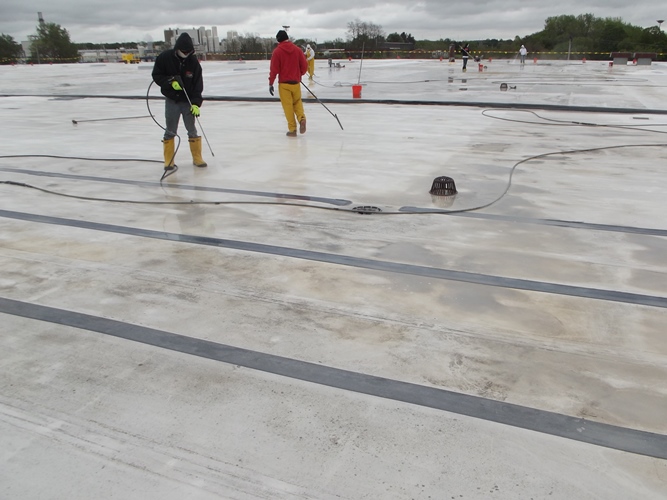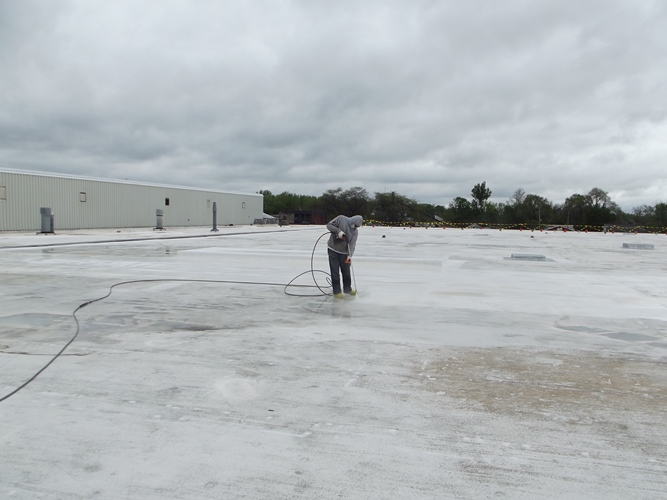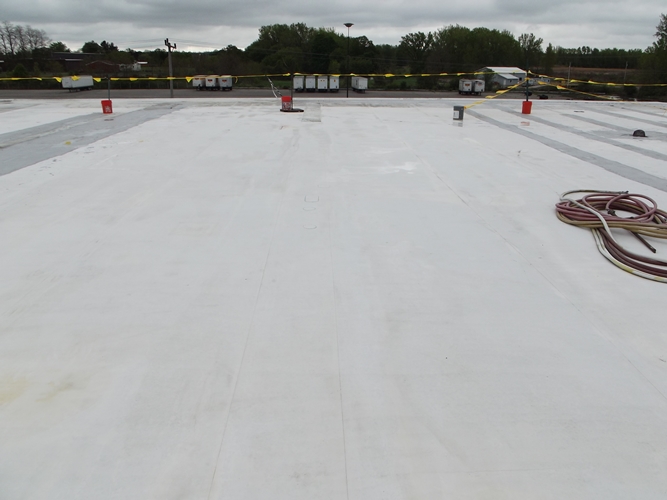DeFranco’s team. That’s what CEO, President, and certified football coach Jeff DeFranco calls his 20-person coatings crew from N.Y. State Industrial Coatings Inc. The 30-person company follows several of his philosophies. A sense of a team, developed safety culture, and a complex game plan to exceed the customer’s expectations are a few of the highlights. Along with the supporting staff and superintendent, the crew used those highlights from start to finish to achieve a victory on this multi-roof recoat project.
Step It Up
The client, Chapin Manufacturing, runs a facility for a variety of sprayers that may be used in the coatings industry…one of which was used to help clean the roof on this job! At this facility, the at-height substrates were a mix of ethylene propylene diene terpolymer (EPDM), single-ply membrane, and asphalt-modified bitumen. And all of the roofs had a thing or two in common: they were 20+ years old and leaking.
The crew’s solution to that leaky problem was to install a waterproofing system by American WeatherStar to all 150,000 square feet (13,935.5 m²) of rooftop. To install the urethane and silicone system, they used a variety of methods, including squeegeeing, rolling, and spraying. But to start, they had to repair the leaking areas. That included cutting any stretched or stressed material, drying any wet insulation underneath, and patching with a 60-mil (1,524.0 microns) EPDM Carlisle material. DeFranco compared that material to a bicycle tire patch, and because of the size of the project, the crew needed to eliminate any reentry of contaminants, so they prepped as they went.
The next step was a wash down. The team sprayed the roof with a trisodium phosphate substitute detergent, scrubbed it with brushes, pressure washed, irrigated, and then squeegeed it dry. On this rooftop job, there were many steps within a step!

To continue the prep, N.Y. State Industrial worked on the seams and penetrations next. They used the same Urethane 520 material in the system, but they reinforced these areas with a polyester mesh. After all of that “extensive” prep, as DeFranco called it, they were finally ready to move onto the coating system.
On all roofs, the crew applied a full coat of the Urethane 520. They used spray guns when possible but squeegeed it on areas where overspray was a concern. That was applied at 1.5 gallons (5.7 L) per 100 square feet (9.3 m²), and it was followed by a layer of Silicone 410 at the same thickness, giving the roof ultraviolet resistance and a high reflectivity factor. The roofs that were made of asphalt and had extensive alligatoring received one more layer: an additional pass of American WeatherStar’s Asphalt Emulsion 90, which was applied at 4 gallons (15.1 L) per 100 square feet (9.3 m²) to fill any voids.

Water, Water Everywhere
Working on a coatings job out in the elements meant having to pay close attention to the weather. They couldn’t coat on a wet substrate, after all! The crew’s supervisors depended on the help of the technical support in the office and the field supervisors to watch out for incoming storms.
“It’s summer here in the Great Lakes region, so we’d have…thunderstorms due to the instability,” DeFranco said. “In addition to monitoring the radar, a watchful eye was kept on site as storms sometimes manifested in a short period of time prior to radar detection.” Just like in sports, seeing lighting or hearing thunder meant getting off the roof and heading for shelter inside the facility.
“At that point, the game’s called for that day as storms are imminent,” DeFranco explained. “Lightning should always be respected on any exterior coating project — or activity, for that matter.”
When the rain didn’t come, the crew had to contend with the heat. “Hats off to the crew,” DeFranco said. They had to work through the thunderstorms as well as the heat. To tackle the latter, they took frequent breaks for water and shade. The supervisors also monitored the crew members’ exposure to the elements. “I have great respect for the crew to be able to work through those conditions,” DeFranco continued. “They are physically fit athletes.”
They also used a Site-Specific Safety Plan (SSSP) and a fall protection plan within that, and they had a safety director. And because they worked at height, they installed flag lines and stanchions at the proper distance from the leading edge. Most of the work took place within those boundaries, but anything done outside of that line required the use of fall protection.
Customer Service
There were no incidents on this project — for both the safety of the crew and the application of the coatings. They were sure to avoid as much disruption to the client as possible. That meant working at nights and on weekends when applying any materials near the heating, ventilation, and air conditioning (HVAC) systems. Despite being high solids, working near HVAC systems where odors can migrate can potentially be annoying for sensitive noses inside the building.
Since the job’s completion, DeFranco has checked in with the client periodically to “ensure that our installation is meeting their expectation,” he explained. It’s a great courtesy to the building owner — and maybe not used as often as it should be. “That’s our philosophy: let’s engage our clients, embrace them, and be there to fulfill their needs. It’s been our successful business plan for more than three decades and we have committed to grow our company by continuing to deliver the highest level of service the industry has to offer through engineering solutions to our clients’ problems,” DeFranco said.
And at the end of the 16-week-long job, N.Y. State Industrial gave the client what it wanted: a leak-free, cool roof that should last for years to come. Touchdown!
